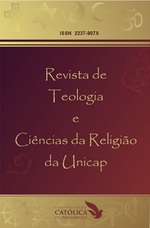INDIGENOUS RELIGIOSITY IN AMERICAS
DOI:
https://doi.org/10.25247/paralellus.2020.v11n26.p029-044Keywords:
Belief. Natives. Practice. Ritual.Abstract
A lot has been said and written about native religions, possibly in an effort to better understand the cultures of native peoples in the Americas. In this work we are searching for a more general vision about this question, analyzing not only the native peoples of Brazil, for instance, but also the data obtained about religiosity among the descendants of the original peoples of the Americas, North, Central and South, not only to obtain a d clearer and more general understanding about the belief systems of these cultures, but also to evaluate the similarities and differences among such systems before and after the European invasions, when new beliefs, religious and in general, were being imposed upon the native peoples. First, we wish to analyze the differences between what is being known as religion and what is understood as spirituality, coming to conclude that the native belief systems are based rather on an original spirituality, or rather that there is a larger tie with what they understand as nature’s spirits, than on religions which carry on dogmas as that determines a rigid separation between belief system and political state in the same society. We came to the conclusion that indigenous peoples, through their ancestors, search for and are adapted to believe in nature’s spirits, which allow them to live in a special state of being and behavior. This gives them meaning to their lives, and to their both inter as extra tribal relations, as such beliefs are followed both individually and collectively, meanwhile not being characterized as dogmatic impositions. Nowadays, traditional spiritual practices are mixed with contemporaneous religious practices among white Europeans as well as black Africans, though these have been banished and denied of their authenticity by the European invasors. In this work, therefore, we examine specific cases of religiosity among antive peoples in the North, Central and South America, focusing on the Guatemalan Mayas, the Peruvian Laika and the Xoco and Kariri-Xoco of Brazil.Downloads
References
MOLESKY-POZ, JEAN. Contemporary Maya Spirituality: The Ancient Ways Are Not Lost. Austin: University of TExas Press, 2006.
MOTA, Clarice Novaes da. Os filhos da Jurema na Floresta dos Espíritos: ritual e cura entre dois grupos indígenas do Nordeste brasileiro. Maceió: Universidade Federal de Alagoas, 1997.
RUFINO, Marcos Pereira. Nem só de pregação vive a missão. In: Povos Indígenas no Brasil, 1996/2000. São Paulo: ISA, 2000.
VILLOLDO, ALBERTO. The Heart of the Shaman: Stories and Practices of the Luminous Warrior. USA: Hay House, 2018.
Downloads
Published
Issue
Section
License
A submissão de originais para a Paralellus implica a transferência, pelos autores, dos direitos de publicação eletrônica. Os direitos autorais para os artigos veiculados neste periódico são do autor; todavia, são da revista os direitos sobre a primeira publicação. Os autores somente poderão fazer uso dos mesmos resultados em outras publicações se indicarem, claramente, que a Paralellus foi o meio originalmente utilizado. Em decorrência do fato de ser a Paralellus uma revista de acesso público, é permitida a utilização gratuita dos artigos em aplicações educacionais e/ou científicas não comerciais, desde que respeitando-se a exigência de citação da fonte (Texto atualizado em 16-11-2020).

















